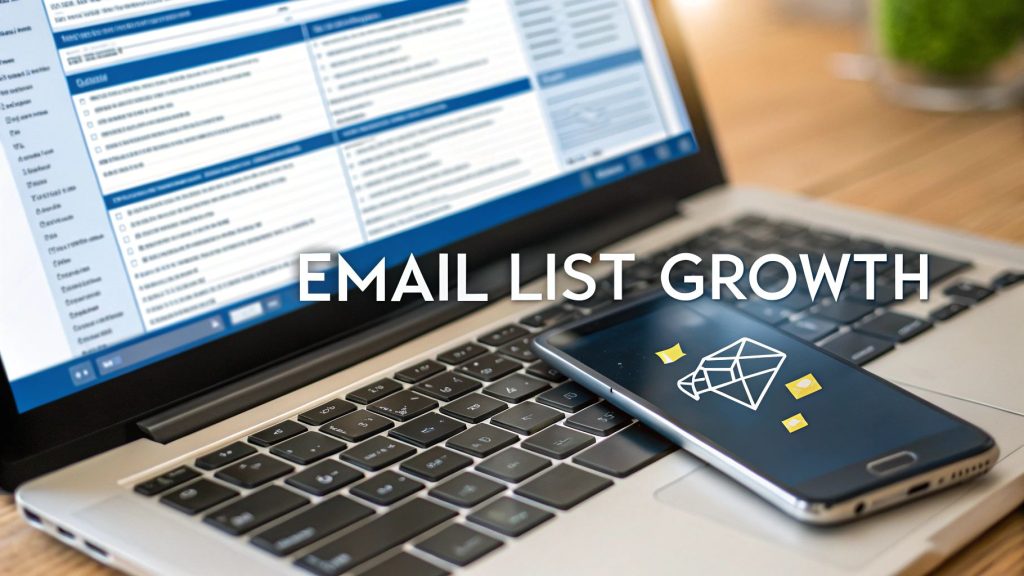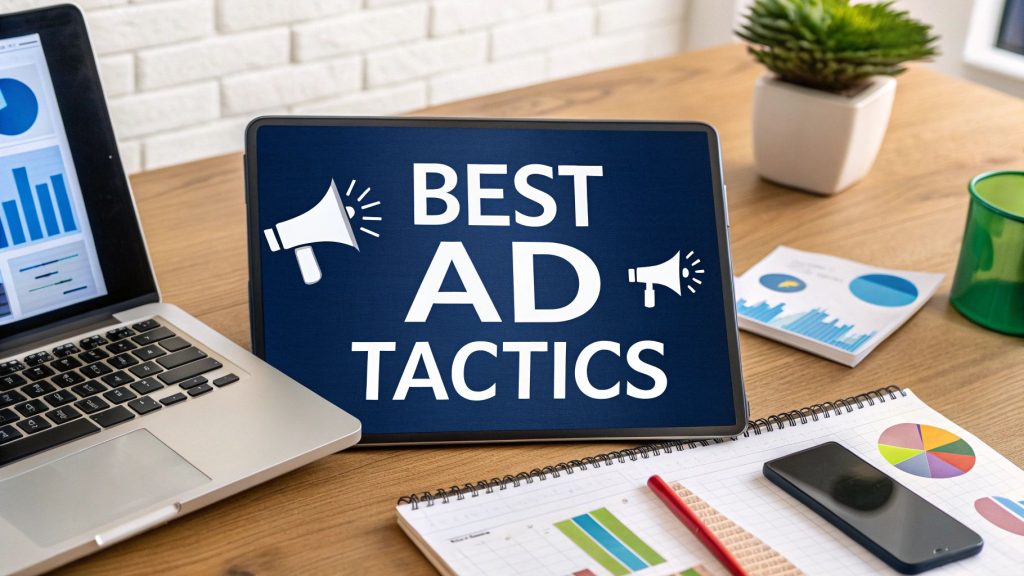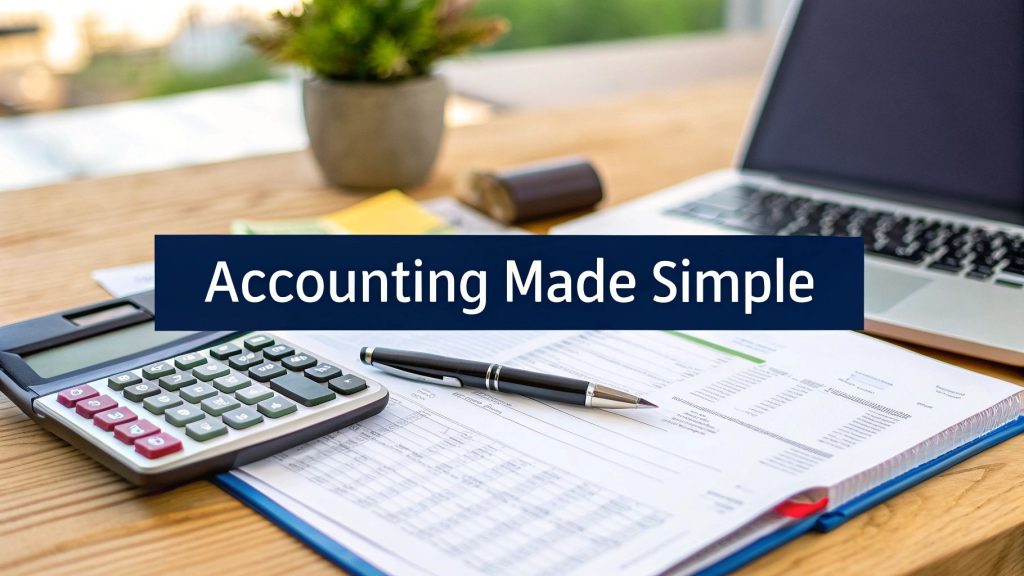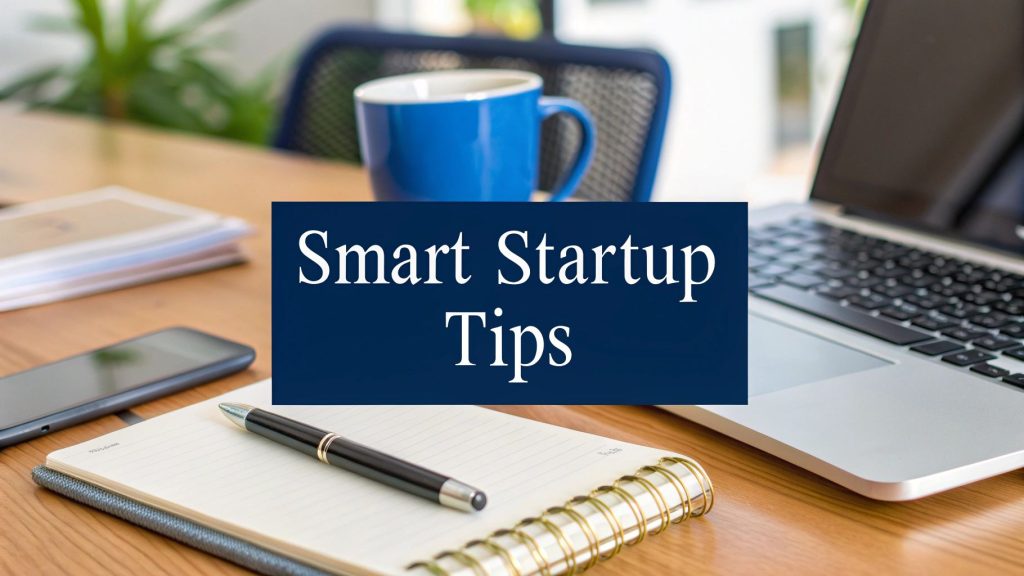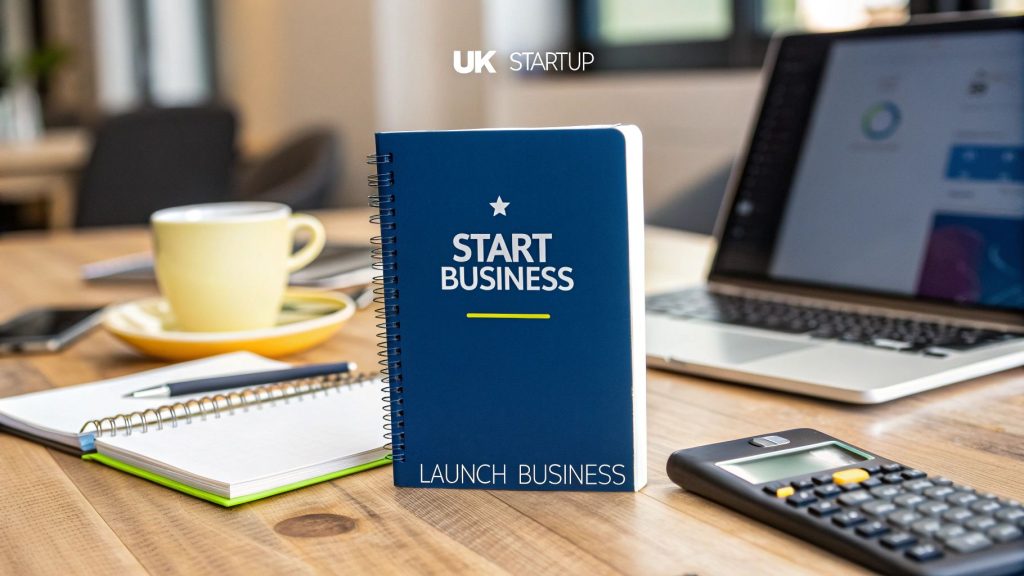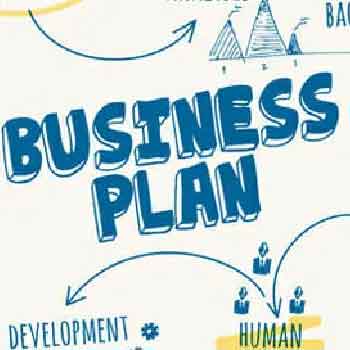Business Plan Executive Summary
The executive summary is the most critical page of your entire business plan. It’s your one chance to capture an investor’s attention, tell a compelling story, and convince them to read on. A weak summary means your detailed plan ends up in the bin, unread. But a powerful, well-structured summary opens doors to funding, partnerships, and strategic opportunities. It’s not just a summary; it’s your business’s first impression and your most important sales pitch, condensed into a single, persuasive page. Getting it right is non-negotiable for any entrepreneur seeking investment or loans.
This guide moves beyond generic advice. We will dissect eight distinct business plan executive summary examples from a range of sectors, including tech start-ups, e-commerce, and social enterprises. For each example, we will break down the specific strategies that make it effective, analysing its structure, language, and core message. You won’t just see what a good summary looks like; you’ll understand why it works and learn how to replicate its success. Our goal is to provide you with actionable takeaways and a clear framework to craft an executive summary that commands attention and gets you to the next meeting.
1. Tech Startup Executive Summary – Airbnb’s Original Business Plan
Airbnb’s original executive summary is a masterclass in pitching a disruptive idea. It didn’t just propose a business; it identified a fundamental shift in consumer behaviour towards the sharing economy. The summary succinctly defined a dual-sided problem: travellers faced expensive, impersonal hotels, while homeowners had valuable, underutilised space.
The proposed solution was elegant: a web platform connecting these two groups, building a community around trust and unique travel experiences. This approach is powerful because it addresses a clear, relatable pain point and offers a simple, technology-driven solution, making it a compelling case study for anyone crafting a business plan executive summary.
Strategic Analysis & Breakdown
The genius of the Airbnb summary lies in its clarity and timing. By positioning themselves at the forefront of the sharing economy trend, they answered the crucial “why now?” question for investors.
- Problem-Solution Framing: They flawlessly articulated the inefficiencies in the market (empty rooms, costly hotels) and presented their platform as the logical, elegant solution. For example, a modern summary might state: “The average UK homeowner has a spare room that sits empty 250 nights a year, representing £2.1 billion in untapped income.”
- Market Opportunity: The summary used compelling data to illustrate the massive size of the travel market, reframing a niche idea (“renting airbeds”) into a scalable attack on the multi-billion dollar hotel industry.
- Simple Revenue Model: The commission-based model was easy to understand. By taking a small percentage from each transaction, the path to profitability was clear and directly tied to growth. A practical example would be: “We will take a 10% commission on each booking, a simple and transparent model that scales directly with our growth.”
Key Insight: A powerful executive summary often sells a vision bigger than the initial product. Airbnb wasn’t just selling rooms; it was selling a new way to travel and belong.
Actionable Takeaways
For entrepreneurs, the Airbnb summary offers a replicable blueprint for capturing attention and investment.
- Lead with the Problem: Start by describing a pain point that resonates deeply with your target audience and potential investors. Make it personal and relatable.
- Quantify the Opportunity: Don’t just say the market is large. Use specific data and market research to show its size and your potential share. For example, state something like, “The UK pet food market is valued at £3 billion, and we are targeting the underserved £250 million premium, organic segment.”
- Demonstrate Traction: Even early-stage validation is powerful. Mention initial user numbers, positive feedback, or successful pilot programmes to prove your concept has legs. For example, “Our beta test with 50 local users resulted in a 95% satisfaction rate and 30 pre-orders.”
- Explain Your “Unfair Advantage”: Clearly state what makes your solution unique. For Airbnb, it was the combination of a trusted community platform and perfect market timing.
2. Restaurant Business Plan Executive Summary
A restaurant executive summary must sell an experience as much as a business. It needs to convey the unique atmosphere, culinary vision, and market niche that will make the establishment succeed. The summary introduces the core concept, defining the problem it solves for diners, such as a lack of healthy fast-casual options or a desire for an authentic, high-end ethnic dining experience.
The proposed solution is the restaurant itself, detailed through its menu highlights, location strategy, and target demographic. Think of how Shake Shack’s original plan focused on premium ingredients and community engagement to elevate the classic burger joint. This approach is effective because it blends passion with practicality, assuring investors that a compelling concept is backed by a solid, profitable business model.
Strategic Analysis & Breakdown
The strength of a great restaurant summary is its ability to create desire while demonstrating viability. It must answer why this specific concept will thrive in a chosen location, right now.
- Concept & Niche: It clearly defines the restaurant’s identity and its unique selling proposition (USP). Is it farm-to-table, fast-casual, or fine dining? The summary for a concept like Sweetgreen, for instance, would have heavily emphasised its focus on healthy, customisable salads for a time-poor, health-conscious urban professional.
- Location & Market: The summary provides a data-driven rationale for the chosen location, analysing local demographics, foot traffic, and the competitive landscape to prove a clear market gap exists. A practical example: “Our chosen site on High Street sees an average daily footfall of 15,000 people and is surrounded by five large office buildings with over 3,000 employees, yet there are no dedicated healthy lunch options within a 10-minute walk.”
- Team Expertise: It highlights the experience of the core team, from the chef’s culinary background to the management’s operational and financial acumen. This builds crucial investor confidence.
Key Insight: A winning restaurant summary doesn’t just describe food; it sells a complete, repeatable customer experience and the profitable system designed to deliver it.
Actionable Takeaways
For aspiring restaurateurs, a well-crafted summary is the crucial first step in securing funding and crystallising the business vision.
- Paint a Vivid Picture: Use descriptive language to articulate your restaurant’s concept, atmosphere, and culinary philosophy. Make the reader want to dine there.
- Anchor with Data: Back up your vision with hard numbers. Include demographic data for your target location, competitor analysis, and realistic financial projections (e.g., “We project £450,000 in first-year revenue based on 60 seats with an average of 1.5 turns per night and a £35 spend per head.”).
- Showcase Your A-Team: Emphasise the skills and experience of your management and culinary team. This is often the most critical factor for investors in the hospitality industry.
- Define the Financials Clearly: Present a simple, understandable overview of your start-up costs, projected revenue streams, and key performance indicators like break-even point and profit margins.
3. SaaS (Software as a Service) Executive Summary – Slack Model
A SaaS executive summary must prioritise metrics that prove a sustainable, scalable business model. The Slack model is a perfect case study, demonstrating how to communicate the value of a platform built on recurring revenue. It focuses on solving a clear, pervasive problem: fragmented and inefficient workplace communication, buried in endless email chains and disparate tools.

The solution Slack presented was a unified, channel-based messaging platform that made collaboration simpler and more organised. This approach is highly effective for SaaS business plan executive summary examples because it highlights not just a product, but a clear go-to-market strategy (freemium) and a powerful growth engine (viral adoption within teams), which are vital signals for investors.
Strategic Analysis & Breakdown
Slack’s executive summary brilliance came from its laser focus on unit economics and product-led growth. It sold a vision of a new “work operating system” while grounding its potential in cold, hard metrics that demonstrated a profitable and repeatable customer acquisition model.
- Problem-Solution Framing: Slack identified the high cost of context-switching and information silos in modern businesses, positioning its platform as the central hub that streamlines communication and boosts productivity.
- Viral Go-to-Market Strategy: The freemium model was key. It allowed teams to adopt the tool organically without a lengthy sales process. As usage grew and teams hit limits, the product sold itself, creating a low-cost, viral acquisition loop.
- Key Metrics Focus: The summary would have emphasised Monthly Recurring Revenue (MRR), low churn rates, and a healthy Lifetime Value (LTV) to Customer Acquisition Cost (CAC) ratio. For example: “With an average LTV of £1,200 and a CAC of £250, our LTV:CAC ratio is 4.8, demonstrating a highly profitable customer acquisition model.”
Key Insight: For a SaaS business, the summary must prove the model works. It’s less about a single sale and more about demonstrating a predictable, recurring revenue machine with strong customer retention.
Actionable Takeaways
Entrepreneurs building a SaaS company can use the Slack model to craft a compelling summary that showcases both vision and viability.
- Lead with Unit Economics: Immediately highlight your LTV:CAC ratio and payback period. These metrics are the language of SaaS investors and prove your business model is sound. For example: “Our LTV:CAC ratio is 5:1 with a 4-month payback period.”
- Showcase Your Growth Engine: Clearly explain your customer acquisition strategy. Whether it’s a freemium model, content marketing, or direct sales, show how you will acquire users efficiently and at scale.
- Demonstrate Product-Market Fit: Use early data to prove people love your product. Mention active user numbers, positive testimonials, or low churn rates to show your solution solves a real problem.
- Outline Your Scalability: Explain how your technology and business model are built to scale. Investors want to see a clear path from your current stage to becoming a market leader.
4. E-commerce Business Plan Executive Summary – Direct-to-Consumer Model
A direct-to-consumer (DTC) executive summary champions a modern retail strategy that bypasses traditional distributors and retailers. This model, popularised by brands like Warby Parker and Casper, focuses on selling directly to customers online. The summary highlights a core value proposition: offering higher-quality products at lower prices by eliminating middlemen, while retaining full control over brand messaging and customer data.

The narrative centres on building a strong digital presence and a direct relationship with the consumer. It outlines how this approach allows for better margins, agile product development based on direct feedback, and the creation of a loyal community. This makes it an ideal framework for any entrepreneur looking to disrupt a traditional market with a focused, data-driven e-commerce strategy.
Strategic Analysis & Breakdown
The strength of a DTC executive summary is its clear focus on customer acquisition and lifetime value. It shifts the conversation from wholesale partnerships to direct marketing funnels and brand loyalty.
- Disruptive Value Proposition: It clearly defines how it offers superior value, whether through price (Dollar Shave Club), convenience (Casper’s bed-in-a-box), or quality and sustainability (Allbirds).
- Data-Driven Operations: The summary emphasises ownership of customer data, which informs everything from marketing spend and product development to inventory management. For example, “By analysing purchase data, we identified a demand for a new product flavour, which we developed and launched in six weeks, generating £50k in its first month.”
- Brand as the Moat: Unlike traditional retail, the brand itself is the primary competitive advantage. The summary explains how content, community, and customer experience will build a defensible brand.
Key Insight: A DTC executive summary must prove you can not only create a great product but also acquire customers profitably and build a brand that people love and trust.
Actionable Takeaways
For entrepreneurs building an e-commerce brand, a DTC-focused summary provides a clear roadmap for convincing stakeholders.
- Articulate Your Niche: Clearly define the specific customer segment you are targeting and why existing solutions fail them. Be precise about the gap you are filling.
- Show Your Funnel: Explain your customer acquisition strategy. Outline the key channels (e.g., social media ads, influencer marketing) and provide realistic estimates for Customer Acquisition Cost (CAC), such as: “Our primary acquisition channel is Instagram ads, with a projected CAC of £15 per customer.”
- Detail the Supply Chain: Demonstrate a solid understanding of your manufacturing and logistics. Show that you have a reliable plan to get products from the factory to the customer’s doorstep efficiently.
- Focus on Retention: Acquiring a customer is only the first step. Outline your strategy for encouraging repeat purchases and increasing customer lifetime value (LTV), such as email marketing or loyalty programmes.
5. Social Enterprise/Non-Profit Business Plan Executive Summary
A social enterprise executive summary must achieve a delicate balance, showcasing a compelling social mission alongside a robust plan for financial sustainability. Unlike purely commercial plans, it leads with the “why” – the critical social or environmental problem it aims to solve. It clearly defines the mission, the beneficiaries, and the innovative approach that creates lasting impact.
This summary frames the business as a vehicle for change, where success is measured in both profit and purpose. For instance, the model popularised by TOMS Shoes or Charity: Water blended a clear, marketable concept with a powerful, easy-to-understand social outcome. This dual-focus approach is essential for attracting investors, donors, and customers who are motivated by more than just the bottom line, making it a crucial tool for modern, mission-driven organisations.
Strategic Analysis & Breakdown
The power of a social enterprise summary is its ability to connect a financial model directly to a social outcome. It answers the question, “How does your business make the world a better place?” by integrating impact into its core operational DNA rather than treating it as a secondary benefit.
- Mission-Driven Narrative: The summary must lead with a powerful, emotionally resonant story about the problem being addressed. It’s not just about market gaps; it’s about human or environmental needs.
- Blended Value Proposition: It clearly articulates how the enterprise creates both social value (e.g., lives improved, carbon reduced) and economic value (e.g., revenue, jobs). A practical example might be: “For every £10 coffee bag sold, we provide one day of clean drinking water for a family in Ethiopia, directly linking our commercial success to our social impact.”
- Sustainability Model: The summary must prove the model is financially viable without relying on perpetual donations. Whether through an earned-revenue model or a structured funding strategy, it must demonstrate a clear path to long-term operational independence. For those structuring their organisation, it’s helpful to understand the nuances of running a business as a community interest company.
Key Insight: The most effective social enterprise summaries don’t just ask for investment; they invite stakeholders to become part of a movement for change.
Actionable Takeaways
For social entrepreneurs, this type of summary is your primary tool for building a coalition of support.
- Lead with Impact: Begin with the compelling social problem. Use data and storytelling to illustrate the scale and human cost of the issue you are tackling.
- Quantify Your Mission: Define specific, measurable, achievable, relevant, and time-bound (SMART) goals for your social impact. For example, state, “Our goal is to provide 10,000 hours of job training to formerly homeless individuals in our first two years of operation.”
- Explain Your “Engine for Good”: Clearly detail how your business operations generate the revenue that funds your mission. Show the direct link between a sale and a social outcome.
- Show Your Team’s Passion: Include brief bios that highlight not only professional expertise but also a deep, personal commitment to the cause. This builds trust and credibility.
6. Franchise Business Plan Executive Summary
A franchise executive summary is unique as it balances the proven strength of a parent brand with a highly localised business case. It must convince stakeholders that the franchisor’s successful model, like that of The UPS Store or Anytime Fitness, can be replicated profitably in a specific new territory by a specific operator. The summary doesn’t invent a new concept; it argues for the expert execution of an established one.
The document demonstrates that the prospective franchisee has conducted rigorous due diligence on both the franchise system and the local market. It leverages the brand’s credibility while showcasing the operator’s understanding of local demographics, competition, and site-specific opportunities, presenting a compelling, lower-risk investment compared to starting from scratch.
Strategic Analysis & Breakdown
The power of a franchise summary lies in its blend of macro-validation and micro-analysis. It leverages the franchisor’s history of success as proof of concept, allowing the franchisee to focus entirely on the “where” and “who” of the new location.
- Dual-Focus Pitch: The summary effectively sells two things at once: the viability of the established franchise model (e.g., Subway’s low-cost, high-volume system) and the untapped potential of the proposed local market.
- De-risked Projections: Financial forecasts are not speculative. They are grounded in the franchisor’s official performance data, often from the Franchise Disclosure Document (FDD), and then adjusted for local economic realities. For example: “The FDD shows average gross sales of £500,000. We project £450,000 for Year 1, a 10% conservative adjustment to account for a new market entry.”
- Operator Competence: It places a heavy emphasis on the franchisee’s qualifications and management team. The summary must prove they are the right partner to uphold brand standards and execute the operational plan.
Key Insight: A franchise executive summary isn’t selling a novel idea; it’s selling meticulous, localised execution of a proven formula. Success hinges on proving you’ve found the perfect intersection of brand, location, and operator.
Actionable Takeaways
For aspiring franchisees, this type of summary is a crucial tool for securing financing and franchisor approval.
- Lead with Brand Strength: Begin by briefly summarising the franchisor’s success, brand recognition, and market position. This immediately establishes credibility.
- Showcase Local Mastery: Dedicate significant space to your local market analysis. Use demographic data, foot traffic counts, and competitive analysis to prove your chosen territory is primed for success. For example, “The proposed site is in a retail park with 1.2 million annual visitors and is the only fast-food franchise within a 3-mile radius.”
- Justify Financial Projections: Clearly reference the franchisor’s FDD data (like Item 19) as your baseline, then explain your assumptions for adjusting those figures to your specific location and market conditions.
- Highlight Your Team’s Expertise: Emphasise your management experience, operational skills, and any specific knowledge relevant to the industry. The franchisor and lenders are investing in you as much as the location. For more details on legal frameworks, you can learn more about choosing the right business structure in the UK.
7. Product Invention/Manufacturing Business Plan Executive Summary
An executive summary for a product invention focuses on the journey from a unique idea to a tangible, marketable item. Unlike purely digital ventures, it must address the complexities of physical product development, intellectual property, manufacturing, and supply chain logistics. This summary needs to sell not just the product’s vision but also the operational competence to bring it to life, as exemplified by brands like Ring and Dyson.
This visual timeline illustrates the typical phased journey from initial idea to market readiness for a new physical product.
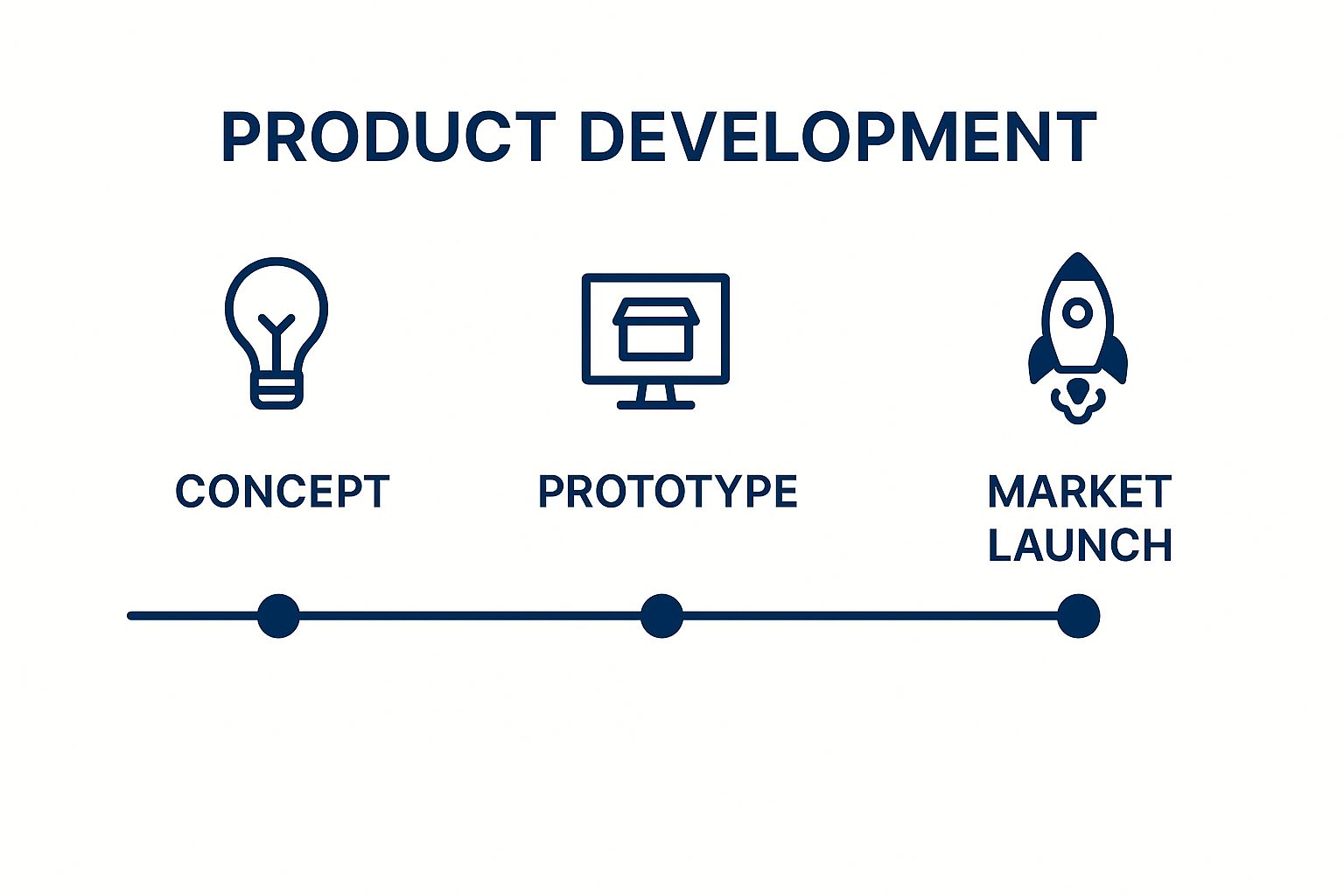
The infographic highlights the critical, sequential stages that de-risk the venture, proving a concept’s viability before scaling to a full market launch. The proposed summary must clearly define the problem the invention solves, its innovative features, the target consumer, and the path from prototype to profitable mass production, making it a crucial tool for securing funding and retail partnerships.
Strategic Analysis & Breakdown
The strength of a product-focused summary lies in its ability to balance creativity with logistical reality. It must convince investors that the unique product can be manufactured reliably and cost-effectively.
- Unique Selling Proposition (USP): It must flawlessly articulate what makes the product different and better. For Scrub Daddy, it was the temperature-controlled texture; for PopSockets, it was the simple, collapsible utility.
- Path to Profitability: The summary must clearly outline manufacturing costs, proposed retail price, and expected margins. A practical example: “Our cost per unit is £2.50, our wholesale price is £7.50, and the recommended retail price (RRP) is £14.99, yielding a 67% margin for us and a 50% margin for retailers.”
- Intellectual Property (IP) Strategy: A clear plan for protecting the invention through patents, trademarks, or design rights is non-negotiable. This protects the core competitive advantage.
Key Insight: For a physical product, the executive summary must tell a compelling story about both the “what” (the invention) and the “how” (the manufacturing and distribution plan).
Actionable Takeaways
For inventors and product designers, this type of summary provides a blueprint for turning a great idea into a viable business.
- Lead with the Innovation: Immediately explain the product’s unique feature or the problem it solves. Use high-quality renderings or photos to make the concept tangible.
- Prove Market Demand: Don’t just claim people will buy it; show it. Use data from surveys, successful crowdfunding campaigns (like PopSockets), or letters of intent from potential retailers. For example, “Our Kickstarter campaign was 300% funded, raising £75,000 from 1,500 backers in 30 days.”
- Detail the Production Plan: Be transparent about your manufacturing strategy. Name potential partners, outline production costs, and address potential supply chain risks with clear mitigation plans.
- Define Your Go-to-Market Strategy: Explain how you will get the product into customers’ hands. Will you sell direct-to-consumer online, through major retailers, or via distributors? Show you understand the channel.
8. Consulting/Professional Services Business Plan Executive Summary
A consulting or professional services executive summary pivots from a physical product to human capital. Its primary goal is to sell expertise, trust, and a proven methodology. The summary must quickly establish the credibility of the founders and articulate a clear value proposition for a defined target client, demonstrating how specialised knowledge solves expensive business problems.
This type of summary focuses on the team’s track record, unique service offerings, and a scalable client acquisition strategy. For instance, a boutique marketing consultancy wouldn’t just state they offer SEO; they would highlight their proprietary audit process that has historically increased client lead generation by an average of 70% within six months, showcasing immediate, tangible value.
Strategic Analysis & Breakdown
The power of a services summary lies in its ability to translate intellectual capital into a bankable business model. It addresses the key investor question: “How can this scale beyond the founders’ billable hours?” It builds a case for a sustainable operation, not just a freelance practice.
- Expertise as the Product: The summary must lead with the founders’ credentials, relevant case studies, and testimonials. It’s about proving why this specific team is uniquely qualified to solve the client’s problem.
- Target Client & Pain Point: It must precisely define the ideal client (e.g., “mid-sized B2B SaaS companies in the fintech sector struggling with customer churn rates above 5% monthly”) and the specific, high-cost pain point they address.
- Scalability Model: The summary must outline a clear growth path. This could involve hiring junior consultants, developing licensed training programmes, or creating a productised service model to move beyond purely time-based billing.
Key Insight: A consulting executive summary sells confidence. It must convince readers that the team’s expertise is the lowest-risk, highest-return solution to their specific business challenges.
Actionable Takeaways
For aspiring consultants or service firm founders, this model provides a clear roadmap for creating one of the most effective business plan executive summary examples.
- Lead with Credibility: Begin with a powerful statement about the team’s collective experience and marquee achievements. For example, “Founded by two ex-Deloitte senior managers with a combined 20 years of experience in supply chain optimisation, who have collectively saved Fortune 500 clients over £50 million.”
- Define Your Methodology: Clearly explain your unique approach or framework. Give it a name to make it tangible and proprietary, showing you have a structured, repeatable process for delivering results.
- Show Market Validation: Include letters of intent from potential clients, a list of companies in your pipeline, or data from a pilot project. This demonstrates existing demand for your expertise before you even officially launch and register a business name.
- Be Realistic About Operations: Address key operational metrics directly. Mention your target utilisation rate (e.g., “Our model is based on a 75% billable utilisation rate per consultant”), client acquisition cost, and projected revenue per consultant to show a strong grasp of the business’s financial levers.
Executive Summary Comparison of 8 Business Plan Types
| Business Plan Type | Implementation Complexity 🔄 | Resource Requirements ⚡ | Expected Outcomes 📊 | Ideal Use Cases 💡 | Key Advantages ⭐ |
|---|---|---|---|---|---|
| Tech Startup Executive Summary (Airbnb) | Moderate complexity: clear problem–solution framing, technology-driven | Moderate: minimal startup costs, tech needed | High scalability, network effects, profitability path | Technology-enabled marketplaces disrupting traditional sectors | Strong market disruption narrative, clear revenue model, scalable platform |
| Restaurant Business Plan | Moderate complexity: detailed concept, location, menu, financials | High: significant capital investment | Local market traction, multi-revenue streams | Food & Beverage startups with physical location and strong storytelling | Tangible product, emotional appeal, manageable local focus |
| SaaS Executive Summary (Slack model) | High complexity: subscription metrics, product-market fit, retention | High: initial development and ongoing innovation | Predictable recurring revenue, rapid growth potential | Software businesses relying on subscription and viral growth | Recurring revenue, global scalability, data-driven metrics |
| E-commerce Business Plan (Direct-to-Consumer) | Moderate complexity: marketing funnels, supply chain, customer data | Moderate to high: inventory, digital marketing | Brand building, customer loyalty, margin improvement | Online retail and brand-focused direct sales | Lower overhead, direct customer relationships, flexible scaling |
| Social Enterprise / Non-Profit | High complexity: balancing mission impact and financial sustainability | Variable: mix of grants, earned income | Measurable social outcomes with financial viability | Mission-driven organisations blending impact and business | Access to grant funding, strong emotional appeal, mission alignment |
| Franchise Business Plan | Moderate to high complexity: brand, territory, investment, support | High: upfront fees and royalties | Reduced startup risk, established brand traction | Multi-unit retail or service businesses leveraging proven models | Proven business model, training/support, financing advantages |
| Product Invention / Manufacturing | High complexity: product development, IP protection, manufacturing | Very high: tooling, inventory, marketing costs | Product launch, retail distribution, licensing potential | Physical product innovation to market with IP focus | Tangible product, patent protection, multiple distribution options |
| Consulting / Professional Services | Low to moderate complexity: focus on credentials, client targeting | Low: primarily human capital | Profitable service delivery, strong client relationships | Knowledge-based service firms relying on expertise | Low startup costs, high margins, flexible service adaptation |
From Example to Execution: Crafting Your Winning Summary
We’ve journeyed through a diverse landscape of business plan executive summary examples, from the disruptive pitch of a tech startup like Airbnb to the market-focused precision of a local restaurant. Each example, whether for a SaaS platform, an e-commerce brand, or a social enterprise, offers a unique blueprint for success. Yet, they all share a common DNA: clarity, conviction, and a compelling narrative that answers the most critical questions before they are even asked.
The goal isn’t to copy these summaries word-for-word. Instead, you should view them as a strategic toolkit. Your task now is to select the right tools for your specific venture. Think of it as building a custom vehicle; you might borrow the powerful engine of a SaaS summary (its focus on metrics like ARR and LTV), the chassis of a restaurant plan (its deep understanding of the local market), and the sleek design of a direct-to-consumer brand (its compelling brand story).
Synthesising the Best Strategies
The most effective summaries blend elements from different models to create a narrative that is both comprehensive and persuasive. As you begin to draft your own, consider these core principles distilled from the examples we’ve analysed:
- Lead with the ‘Why’: Every strong summary, from the social enterprise to the product invention, starts with a clear, relatable problem. This immediately grounds your reader and establishes the relevance of your solution.
- Quantify Everything Possible: Vague claims weaken your case. Follow the lead of the SaaS and e-commerce examples by using hard numbers: market size, projected revenue, key performance indicators (KPIs), and your funding request. This transforms your vision from an idea into a tangible investment opportunity.
- Show, Don’t Just Tell: The professional services and franchise examples excel at demonstrating credibility. Highlight your team’s specific expertise, unique methodologies, or established operational models to build immediate trust.
- Craft a Narrative, Not a Report: Your executive summary is the trailer for your business movie. It must have a beginning (the problem), a middle (your innovative solution), and a compelling future (the market opportunity and financial projections). It should leave the reader wanting to know what happens next.
Ultimately, your executive summary is your business’s first handshake. It must be firm, confident, and memorable. By deconstructing these successful business plan executive summary examples, you have gained access to the strategic thinking that captures attention and opens doors. Now is the time to apply those lessons, synthesise the most powerful tactics, and craft a document that not only represents your business but also propels it forward.
Ready to move from analysis to action? A powerful executive summary is just the start. At Grow My Acorn, we provide the tools, resources, and expert guidance to help you build a comprehensive business plan and launch your venture with confidence. Explore our services to turn your brilliant idea into a thriving business. Grow My Acorn


